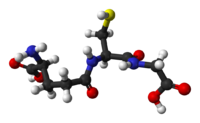
Photo from wikipedia
Antioxidant molecules in honey contributed to various biological effects, but antioxidant components markers in honey are required to be investigated further. Phenolic compounds, flavonoids and free amino acids were analyzed… Click to show full abstract
Antioxidant molecules in honey contributed to various biological effects, but antioxidant components markers in honey are required to be investigated further. Phenolic compounds, flavonoids and free amino acids were analyzed using UPLC-MS/MS and HPLC-FLD from 39 honey samples, in which fennel honey was firstly investigated. Based on the quantitative composition-activity relationship, the cellular antioxidant activity (CAA) assay of various honeys is closely related with the interaction of some phenolic compounds (isoferulic acid, 3,4-dihydroxy benzoic acid, 4-hydroxy benzoic acid, chlorogenic acid, caffeic acid, gallic acid, cryptochlorogenic acid, p-coumaric acid, salicylic acid), flavonoids (isosakuranetin, sakuranetin, pinocembrin, vitexin, taxifolin, galangin, luteolin, chrysin) and free amino acids (Tyr, Gly, Ile, Glu, Val, Phe, Leu, Asp, His, Pro, Ala). The results would be beneficial for the understanding of the nutritional values, exploitation and utilization of honeys with different floral origins, further contributable to the market development and consumption choice of honey.
Journal Title: Food chemistry
Year Published: 2019
Link to full text (if available)
Share on Social Media: Sign Up to like & get
recommendations!